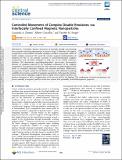Controlled Movement of Complex Double Emulsions via Interfacially Confined Magnetic Nanoparticles
Author(s)
Zentner, Cassandra Aileen; Concellon Allueva, Alberto; Swager, Timothy M
DownloadPublished version (6.911Mb)
Publisher Policy
Publisher Policy
Article is made available in accordance with the publisher's policy and may be subject to US copyright law. Please refer to the publisher's site for terms of use.
Terms of use
Metadata
Show full item recordAbstract
Controlled, dynamic movement of materials through noncontacting forces provides interesting opportunities in systems design. Confinement of magnetic nanoparticles to the interfaces of double emulsions introduces exceptional control of double emulsion movement. We report the selective magnetic functionalization of emulsions by the in situ selective reactions of amine-functionalized magnetic nanoparticles and oil-soluble aldehydes at only one of the double emulsion's interfaces. We demonstrate morphology-dependent macroscopic ferromagnetic behavior of emulsions induced by the interfacial confinement of the magnetic nanoparticles. The attraction and repulsion of the emulsions to applied magnetic fields results in controlled orientation changes and rotational movement. Furthermore, incorporation of liquid crystals into the double emulsions adds additional templating capabilities for precision assembly of magnetic nanoparticles, both along the interface and at point defects. Applying a magnetic field to liquid crystal complex emulsions can produce movement as well as reorganization of the director field in the droplets. The combination of interfacial chemistry and precise assembly of magnetic particles creates new systems with potentially useful field-responsive properties.
Date issued
2020-07Department
Massachusetts Institute of Technology. Department of ChemistryJournal
ACS Central Science
Publisher
American Chemical Society (ACS)
Citation
Zentner, Cassandra A. et al. "Controlled Movement of Complex Double Emulsions via Interfacially Confined Magnetic Nanoparticles." ACS Central Science 6, 8 (July 2020): 1460–1466 © 2020 American Chemical Society
Version: Final published version
ISSN
2374-7943
2374-7951